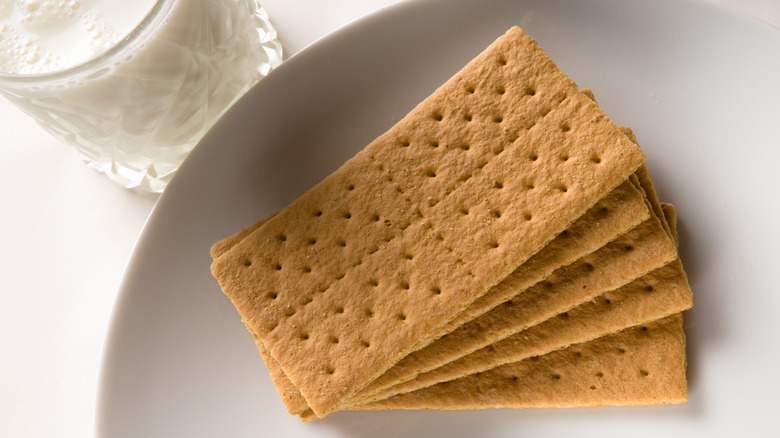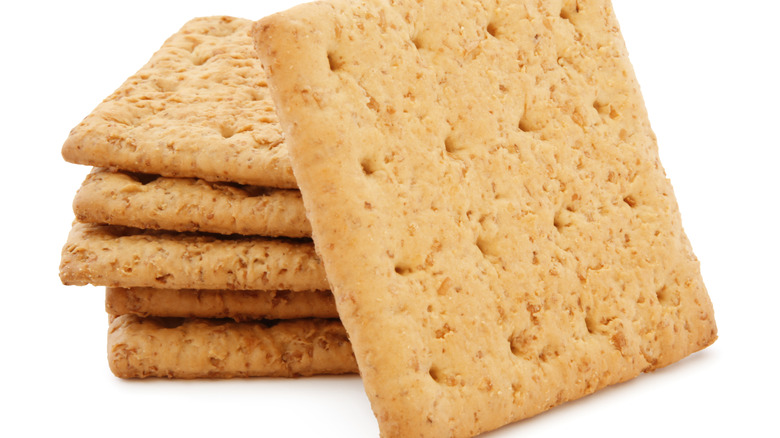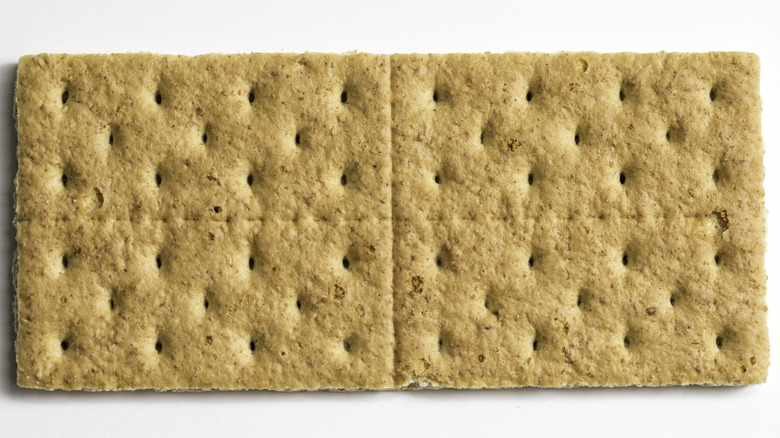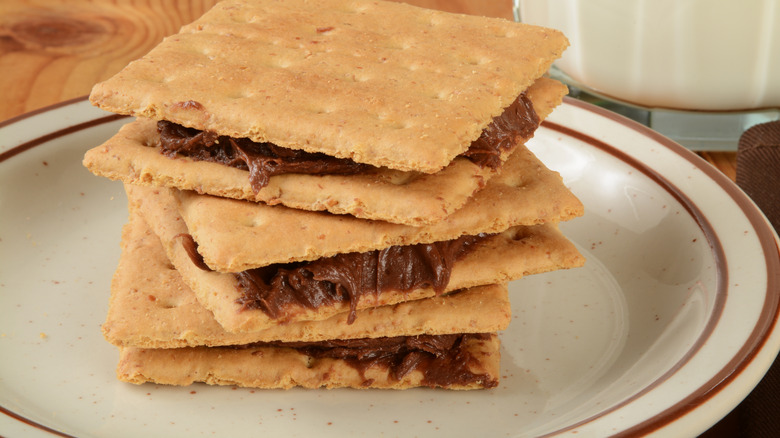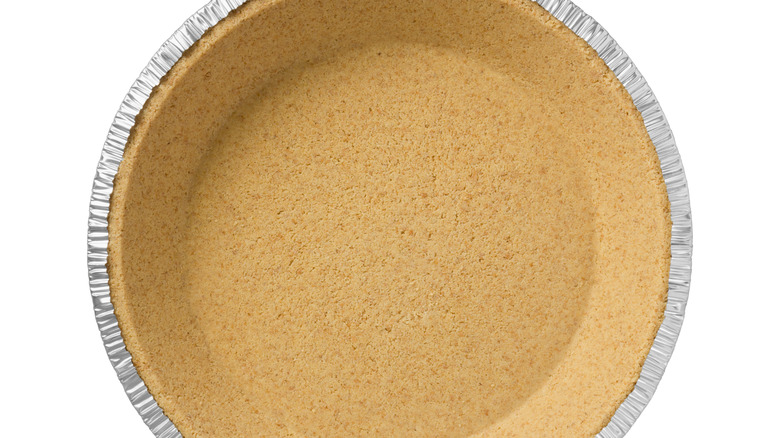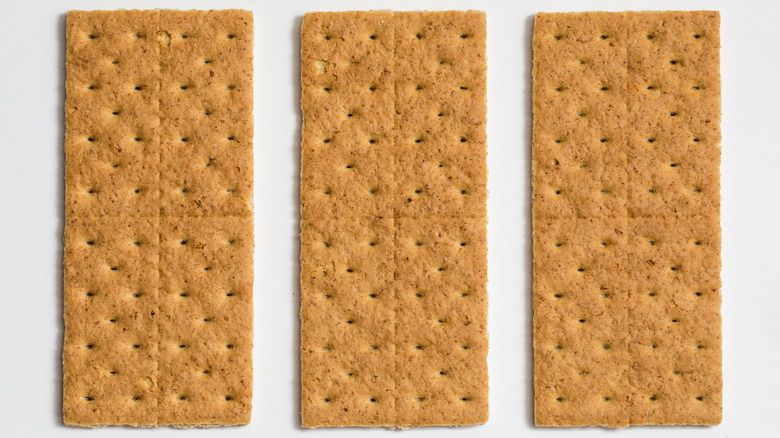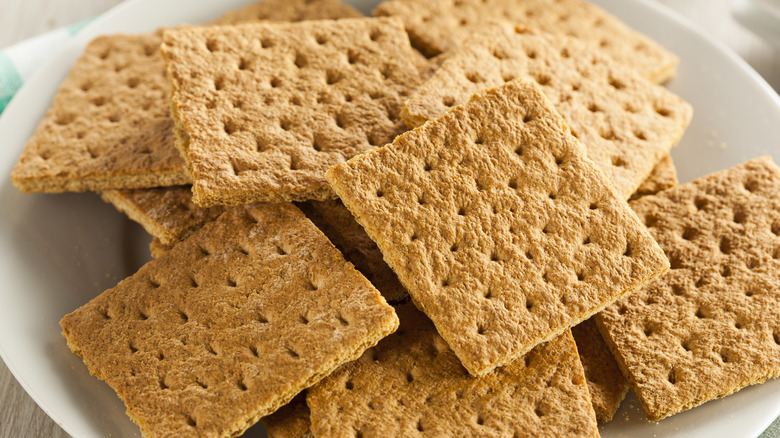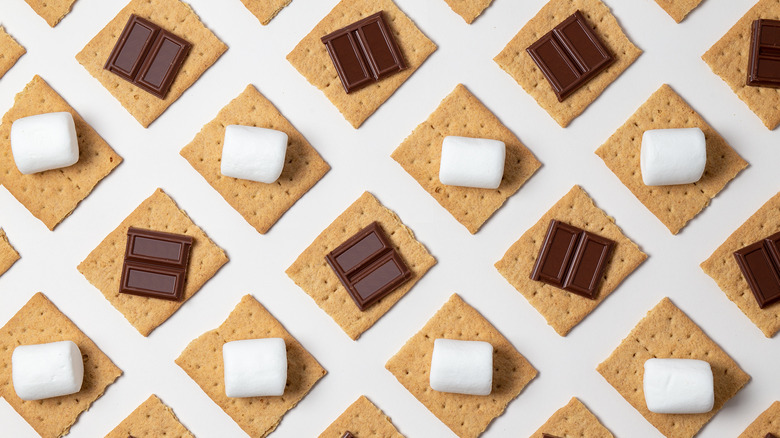7 Things You Probably Didn't Know About Graham Crackers
Few snacks have a reputation for kid-friendly wholesomeness like graham crackers. Many of us have fond memories of enjoying them as an after-school snack with a glass of milk or seeing our mothers use them in homey desserts such as icebox cakes or cheesecakes. And of course, no summer cookout or camping trip would be complete without s'mores — that classic outdoors treat of a graham cracker topped with chocolate and a toasted marshmallow.
Graham crackers' reputation for wholesomeness is intentional. Invented by minister Sylvester Graham in the mid-19th century, they were intended to be not only healthful but biblically correct: Graham believed the key to healthy living was eating as Adam and Eve did in the Garden of Eden, which meant no meat and nothing but plants and water — so the original graham crackers were almost entirely hand-ground, whole-wheat flour. According to Atlas Obscura, he railed against the dangers of traditional baked goods, especially bread, which he called "the most miserable trash that can be imagined." Naturally, this did not go over well with professional bakers, who protested outside his increasingly well-attended talks. But they'd eventually get the last laugh: Today's graham crackers bear little resemblance to Graham's austere creation — and Graham certainly would not approve of s'mores.
They were first developed to curb the sex drive
Many strict vegans have ethical reasons for eschewing meat and dairy, and Sylvester Graham, the inventor of the graham cracker, was no exception. His overriding moral concern, however, wasn't animal welfare, deforestation, or climate change. Instead, it was masturbation. He believed that rich food and drink such as steak and wine aroused the sex drive and led to moral depravity (with masturbation and extramarital sex being the worst offenses) as well as degradation of the body's organs. Even worse, he warned, a population with an unwholesome diet and aroused sex drives would engage in other unsavory practices, leading to the downfall of civilization itself.
He warned that the only way to stay on the straight and narrow was "a plain, simple, unstimulating, vegetable and water diet" — basically, a life sustained by anti-aphrodisiacs, Atlas Obscura reports. He also claimed that his diet protected against disease, a claim that enticed many to embrace his teachings during the New York cholera outbreak of 1832. He specifically designed graham crackers as a wholesome, intentionally uninteresting alternative to bread — in his mind, a buzz kill that could save your life.
The original graham crackers were far from tasty
Sylvester Graham wasn't exactly a fun guy. Besides railing against the dangers of meat, most baked goods, and alcohol, he called for full sexual abstinence except for the purposes of reproduction. And for him, bland, unexciting food was the key to keeping one's carnal desires in check. Food for him had to be not only bland, but as close to its natural form as possible — anything made with grain, for example, had to contain either whole grains or very coarsely ground whole grains. The distinctive nubby texture of today's graham crackers harkens back to Graham's original formulation.
Whole-wheat flour is about the only part of Graham's original vision that remains in today's rich, sweet graham crackers, which almost always contain ingredients Graham would not have approved of, such as shortening and sugar. An early recipe for manufactured graham crackers offers a hint of what Graham's original recipe might have looked and tasted like — it contained only whole wheat flour and water, rolled out and baked, then baked again. In short, it was more like fiber-rich hardtack than a snack anyone would look forward to eating. And for Graham, this was exactly the point.
The first recorded s'mores recipe dates to 1927
It didn't take long for enterprising bakers and eaters to put their own more appetizing spin on the original graham crackers. By 1898, the National Biscuit Company (now called Nabisco) was manufacturing its own line of graham crackers, which were sweetened with sugar, opening the door for incorporating them into other sweet treats.
When roasted marshmallows became trendy in the 1890s (because eaters could sample marshmallows off each other's sticks, marshmallow-roasting parties gained a reputation as venues for flirtation), other marshmallow-stuffed treats — some covered in chocolate — soon hit the market. Mallomars were introduced in 1913, and MoonPies followed shortly after. This suggests that the combination of a pastry base, marshmallow filling, and chocolate was already on the public's radar when the first published recipe for s'mores appeared in the 1927 guidebook "Tramping and Trailing with the Girl Scouts." And graham crackers — just sweet enough without being too sweet or rich — were the perfect base for what would become a new classic.
The graham cracker crust was invented specifically for chiffon pies
Home bakers love graham cracker pie crusts not just for their taste but also for their convenience. Even if you make your own, all you have to do is grind a bunch of crackers (or buy a box of crumbs), mix them with butter, and pat the mixture into a pan — no worries about rolling it out to the proper shape and thickness or improper mixing. It's a simple, low-effort recipe that yields great results.
While graham cracker crusts sound like something devised by a creative home cook, the development of the recipe was in fact painstakingly intentional. Invented by professional baker and cookbook author Monroe Strause in the 1920s, it was developed with a very specific purpose in mind: To serve as a lighter, tastier base for one of his other famous inventions, the chiffon pie. (The chiffon pie in turn was inspired by his hatred of heavy, stodgy cream pies.) His perfectionism and creativity earned him the nickname "The Pie King" and made pies the "it" dessert among Jazz Age Hollywood stars.
The flour in graham crackers is different from ordinary whole-wheat flour
A big reason graham crackers have maintained their reputation for wholesomeness is their distinct, rustic, grainy texture — even mass-produced, hyper-sweetened graham crackers have a bit of bran in them to contribute to their flavor and crunch. For Sylvester Graham, whole grains were the entire point — and pretty much the only ingredient besides water — in his original crackers. According to Food & Wine, he described his healthy creation as made from "finely ground, unbleached wheat flour, wheat bran, and coarsely ground germ."
This mixture, which he called graham flour, was the cornerstone ingredient in the few approved baked goods permitted in the strict vegan diet Graham promoted, and continues to be the main ingredient in today's graham crackers. But contrary to popular belief, it's not just plain whole wheat flour — instead, it's far more coarsely ground, which is why graham crackers have their distinct, grainy texture and mouthfeel. But while graham flour grew to be closely associated with Graham and his teachings, it never occurred to him to profit off the recipe — to him, as long as people were listening to his teachings and leading wholesome, healthy lives, that was reward enough.
The first commercially distributed graham crackers date to 1897
Sylvester Graham never attempted to profit from his recipes, preferring to open-source his teachings in hopes of winning more converts to his healthy eating and healthy living crusade. This strategy succeeded, and the seriously strict lifestyle and diet he promoted won over thousands of followers, some attracted by the prospect of avoiding cholera and other then-poorly-understood contagious diseases. Over time, some of Graham's innovations — such as the graham cracker — worked their way into mainstream culture. And this meant that if he didn't intend to profit from them, someone else would.
While a few early innovators tried unsuccessfully to mass-market the crackers, the first to do so successfully was the National Biscuit Company (now known as Nabisco) in 1898. Unlike Graham's original creation, however, this commercial version was sweetened with sugar — as were most other versions to emerge in the future. Graham would have certainly railed in indignation against such sinful abominations as cinnamon and honey grahams — he believed that spices, and interesting-tasting things in general, inflamed the senses and promoted sexual depravity — but his eponymous crackers were bigger than he was and eventually shed their original identity as sensible survival rations to become a cherished treat.
Modern graham crackers are tasty – but definitely not health food
While today's graham crackers are far richer, sweeter, and more flavorful than the intentionally bland and dull-tasting original, they still have a reputation for wholesomeness — which is probably why they're a go-to snack choice to share with small children. Indeed, the nubby whole grains that still define graham crackers today do make them seem like a healthy option. Certainly Sylvester Graham himself would have approved of all that natural fiber.
Unfortunately, that's about the only healthy thing about today's graham crackers. While they taste way better than the original, as is often the case, all the things that make them tasty — shortening and sweeteners such as brown sugar and molasses — also make them a less-than-ideal choice for those concerned about nutrition. While not as overtly sweet as say, an Oreo, most graham crackers are closer to cookies than crackers in their nutritional profile. "Graham crackers are not so high in calories, but are definitely high in carbs and sugar for the serving size," nutritionist Beth Warren told Women's Health. And sorry, all those nubby bits of bran aren't helping your health as much as you think. "There's also very little fiber and low nutritional value," Warren said.

